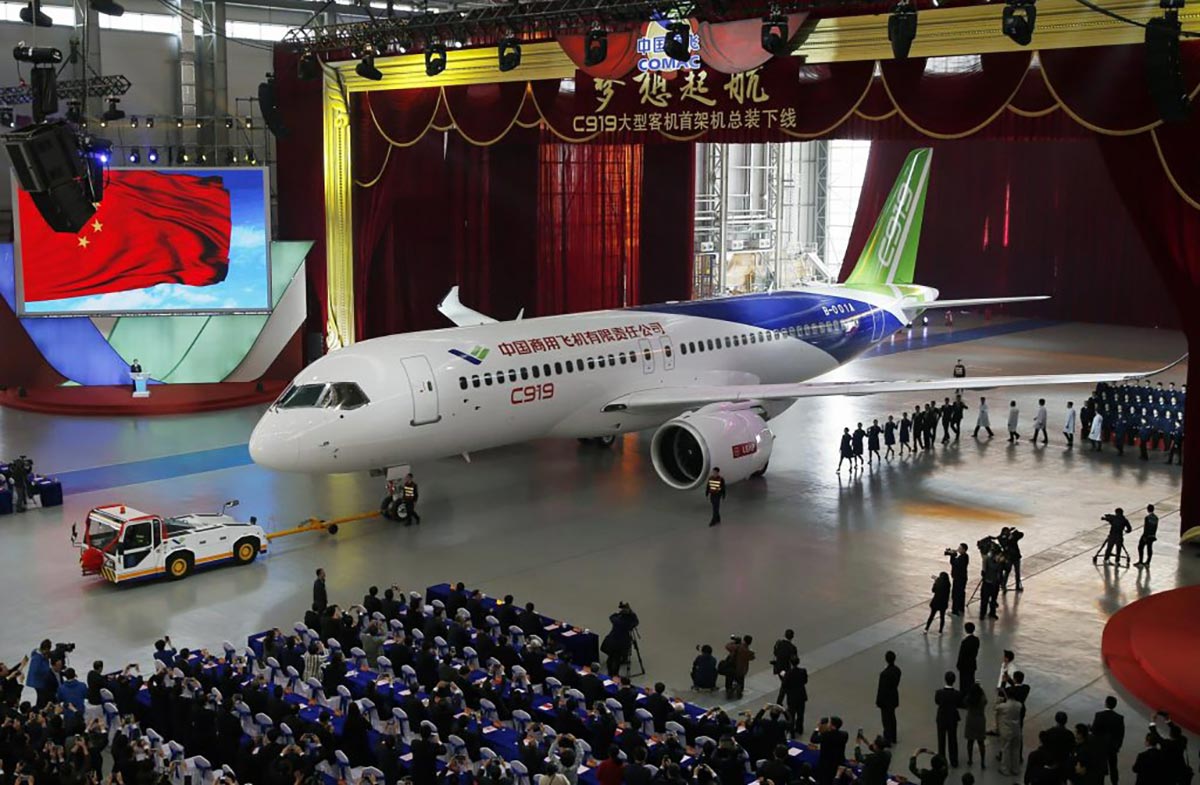Characterized by world-leading economic growth, rising middle class with increasing income, increasing market openness to FDI, and strong policy support from the government, China fuels global investors with large market volume and fast-growing potential in the aerospace sector. As the world’s second-largest civil aviation market, China maintains long-term above-average growth in the aerospace industry.
According to the statistics of the International Air Transport Association (IATA), in 2017 air transport carries more than 556.6 million passengers and contributes 104.3 billion US Dollars GDP. Increasing travel frequency by air in China expedites the establishment of new air routes, delivery of new aircraft and construction of new airports. It is estimated that the current value of Chinese civil aviation market is 950 billion US dollar and the total number of aircraft fleet in 2034 will reach 7210, which triples that number in 2014.
The emergence of the Chinese aerospace industry distinctly reflects new opportunities arising from the dynamics in the aerospace industry. Increase in individual income-level and travel frequency of the middle-class contributes to surging market demand, which as result creates new market niche for aircraft original equipment manufacturers (OEMs). Technological innovation, lower oil price and deregulation lower market entry thresholds with considerable profit margins as well as accelerate replacement cycle of aircraft and related equipment.
These demand-driven factors not only create and amplify the market potential, but also intensifies global competition between airlines, OEMs and multiple-tier suppliers. With the deregulation of market entry and the improvement of intellectual property rights, surging amount of private and overseas capital flows into the market in various forms of linkages in business networks. With strong support from the government, domestic aerospace firms aim to “catch-up” with competitors originated from advanced economies.
Recognized as one of the “strategic emerging industries” by the Chinese government, the aerospace industry serves as a national economic pillar and forerunner of economic growth of the country. Chinese central government provides special funds and enacts preferential policies for domestic firms specialized in the aerospace industry. The foundation of the increasing number of new airline companies, constructions of new international airports, as well as renovations and extension of existing airports provide emerging market niche to enter for both domestic and international players.
Although leading western OEMs of airplanes and aircraft engines still dominates the world aviation market, China managed to build up comprehensive and independent aerospace industry systems settling its roots in the global competition. In 2008, the remerger of AVIC I and AVIC II as the new Aviation Industry Corporation of China (AVIC), as well as the foundation of The Commercial Aircraft Corporation of China (COMAC) signalled the country’s ambition to utilize the national power to challenge the existing order of the global aerospace market. In 2017 the successful test flights of its flagship wide-body passenger aircraft model C919 exhibited the country’s ambition to compete with global giants such as Airbus and Boeing.
Meanwhile, the Chinese government incrementally reforms the institutions and eradicates market entry barriers for foreign multinational enterprises (MNEs) to solve the long-existing problem of inefficiency and low competence. Although the development C919 is largely dependent on the support of the state-owned aerospace business group Aviation Industry Corporation of China (AVIC), COMAC has launched international partnership projects with leading global players such as Airbus (EU), Boeing (USA), Bombardier (Canada) and United Aircraft Corporation (UAC) (Russia).
Numerous world’s leading manufacturers of aircraft engines (e.g. GE Aviation, Honeywell, Rolls Royce) and aeronautic systems (e.g. SAFRAN, UTC-Goodrich, Liebherr, Thales) are also among the list of COMAC’s suppliers. Encouraged by the preferential industrial policies, an increasing number of foreign MNEs enter the Chinese aerospace market in recent years and embed themselves in the local networks via forming diverse business relationships local partners.
For instance, the development of China’s first narrow-body twin jet airliner- C919 Model engaged close technological collaboration between COMAC and global giants such as SAFRAN, GE Aviation, UTC Aerospace Systems, Bombardier. In 2017, the first flight testing of C919 aircraft was successfully launched and soon attracted the interests of buyers (by the end of 2018, COMAC has received in a total of 815 orders from 28 customers). The global expansion of production networks of China’s aerospace industry underlines the dynamism of changing the landscape of the global competition.
For successful market entry in the Chinese aerospace market, it is crucial for foreign investors to understand the dynamics of the Chinese aerospace industry. Based on the analysis of location quotient (LQ) of Chinese aerospace clusters, we discover that:
(1) Many inland provinces with long presence of large aerospace State-Owned-Enterprises (SOEs) have high degree of industrial agglomeration of the aerospace industry with LQ greater than 1. Moreover, these LQ values remain either relative stable (e.g Liaoning, Guizhou, Hunan), or even see a drastic increase (e.g. Sichuan, Shaanxi). This result indicates the tendency of concentration of specialized labour forces in aerospace industry, which serves as a growth engine of the regional economy.
(2) Many costal hotspots of FDI inflows don’t necessarily have high degree of LQ in aerospace industry (e.g. Jiangsu, Zhejiang, Shandong, Guanzhou). This result may due to the high degree of local economic diversity and complexity. Meanwhile, in some cities (e.g. Tianjin and Shanghai), this value increases over the years, which can partly attribute to the contribution of development of plants and R&D centers of aerospace OEMs and their first-tier suppliers (e.g. Airbus(Tianjin), Goodrich Aerostructure Service (Tianjin), COMAC (Shanghai), Boeing (Shanghai)).
(3) In a few provinces that historically have strong presence of aerospace clusters and large SOEs, there is a decline of the LQ of the aerospace industry (e.g. Hubei, Jiangxi, Anhui, Hebei). Considering the strategic importance of the aerospace industry at the national level, we may also anticipate such outcomes are the results of the industrial reorganization that optimize the resources and production capability of the aerospace industry in some less developed regions.
(4) Although there are a large number of state-owned enterprises in the aerospace industry are headquartered in Beijing, the “headquarter effect” is not evident. This phenomenon can be explained by the high degree of economic diversification of the capital city, while also the fact that the functions of Beijing-based aerospace enterprises are mostly concentrated in administration and R&D sectors, which are not dedicated to labor-intensive manufacturing phases.





